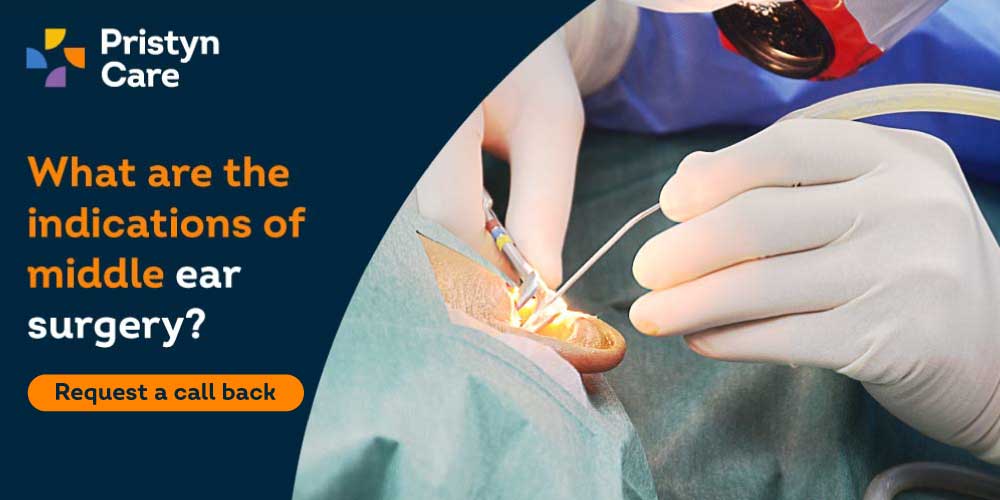![]() Views: 585
Views: 585
What are the indications of middle ear surgery?
Dedicated Support at Every Step!
Our Doctors are available 24 hours a day, 7 days a week to help you!
Some common indications of middle ear surgery are given below.
- Eustachian tube dysfunction
The eustachian tube helps maintain ear pressure and balance and protects the ear from excessive noises and nasal drainage. Eustachian tube dysfunction occurs due to problems with its valves, i.e., the valve can get stuck open or not open properly.
- Otitis media
Otitis media, commonly known as ear infection, is an infection of the middle ear due to viruses or bacteria. Ear infections can lead to discharge being trapped behind the eardrum.
- Eardrum perforation
The eardrum (or tympanic membrane) is an important part of the hearing process. However, it can tear as a result of trauma, loud noises, sudden changes in air pressure, etc. A perforated can’t function properly and doesn’t usually heal on its own. It also increases the chances of the patient getting an ear infection.
- Cholesteatoma
A cholesteatoma is a non-cancerous middle ear cyst that begins at the margin of the eardrum and can grow to invade the middle ear and the mastoid process. It can also lead to degeneration of the middle ear bones. It can be present as a birth defect, but it generally occurs as a result of recurring ear infections.
- Conductive hearing loss
Conductive hearing loss occurs when the patient has a disorder affecting the outer or middle ear, which makes it harder for sounds to pass through them. The patient may be unable to hear soft sounds, and loud sounds may be muffled.
- Otosclerosis
Otosclerosis occurs when there is abnormal bone growth in the ear, which fuses the stapes (stirrup) bone with the surrounding bones, making it hard for the bone to vibrate. It can lead to severe hearing loss, and even deafness in rare cases.

No Cost EMI, Hassle-free Insurance Approval
What are the parts of the middle ear?
Middle ear surgery includes treatments for disorders and dysfunctions of the middle ear canal. The middle ear canal starts with the tympanic membrane, middle ear bones, and mastoid cells. It is the main part of the ear where the sound vibrations are collected and amplified for proper hearing. Parts of the middle ear are:
- Tympanic membrane: The tympanum is a thin tissue membrane that separates the outer and middle ear. It collects the sound vibrations from outside and conducts them to the ossicles for amplification.
- Ossicles (Hammer, Anvil, and Stirrup): The ossicles are a setup made from 3 tiny bones that are responsible for the conduction and amplification of sound vibrations.
- Mastoid cavity in the temporal bone: The mastoid cells surround the ear canal and are responsible for regulating ear pressure and protecting the ear from trauma.
What are the different types of middle ear surgery?
The treatment for middle ear conditions depends on the individual treatment. Some of the common types of middle ear surgery & treatments are:
- Eustachian tube surgeries
Based on the type of eustachian tube dysfunction and its cause, there are different types of treatments for it. Patulous eustachian tube dysfunction is treated through implants, fillers, and graft transfers, but obstructive eustachian tube dysfunction is treated through different surgeries like tympanostomy tube insertion, balloon dilation, etc.
- Myringotomy (with ear tube insertion)
A myringotomy surgery is the drainage of the middle ear fluids, like blood, discharge, etc. It is normally performed for patients with severe ear infections. During the procedure, a small incision/hole is cut into the eardrum to drain any blood, fluids, or pus trapped in the eardrum. In some cases, a small tube, called a tympanostomy tube, is inserted in the eardrum for a little while to help maintain drainage in the long term.
- Tympanoplasty
Tympanoplasty is the treatment of eardrum perforation by repairing the damaged parts of the ear canal using a graft or prosthesis. During tympanoplasty surgery, the injured parts of the ear canal, like the tympanic membrane and the ear ossicles, are removed and replaced using a graft or prosthesis.
- Myringoplasty
Myringoplasty is the most common type of tympanoplasty surgery. A myringoplasty is performed to repair a hole in the eardrum by replacing the tympanic membrane with a graft membrane from somewhere else in the body.
- Ossiculoplasty
Ossiculoplasty is the reconstruction of the middle ear ossicular chain, which has been disrupted or destroyed, using a prosthesis to restore the transfer of sound/vibrations through the middle ear.
- Mastoidectomy
A mastoidectomy is a surgery to remove diseased parts of the mastoid bones. In mild cases, removing diseased cells from the air-filled spaces in the bone is sufficient, but large parts of the bone need to be excised in severe cases. It is generally performed for cholesteatoma or severe ear infections that have spread to the skull. It may also be performed for patients who need cochlear implants.
- Stapedectomy
Stapedectomy is a surgery used to treat hearing loss primarily due to otosclerosis, i.e., damage to the small U-shaped middle ear bone called stapes, by replacing the damaged bone with a prosthesis.
Middle ear surgeries are very common and mostly restore the patient’s hearing without any complications. If you have hearing problems, you should consult an ENT specialist immediately for proper treatment, as delaying treatment for middle ear problems can increase the chances of complications after the surgery.








